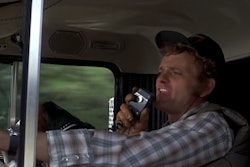The longtime truck driver shortage has gone away, but will return, perhaps as early as next year, according to the American Trucking Associations.
Bob Costello, ATA chief economist and vice president, says the association doesn’t have data indicating when the shortfall changed to what he called a surplus.
“No, there isn’t a shortage today,” Costello says. “But in the long-run, absolutely there will still be a driver shortage, once the economy recovers. Remember, we are in the worst economic downturn in decades. However, any economic activity is expected to be very meager at first, so I don’t expect a driver shortage to return until sometime in 2010.”
Clayton Boyce, ATA press secretary and vice president, says recession factors that temporarily reduced, or in some industry sectors ended, the driver shortage included:
· Freight dropped through 2008.
· Some homebuilding workers switched to driving while construction remained down.
· In the first three quarters of 2008, 2,690 trucking companies with five trucks or more went bankrupt, including some sizeable companies.
Costello adds that overall driver turnover fell to an annualized low rate of 65 percent in the third quarter. By comparison, large truckload driver turnover peaked at 136 percent in the fourth quarters of 2004 and 2005, when freight was strong. Until recently, the lowest turnover for large TL carriers was 77 percent in the fourth quarter of 1997.

“This is the first time in 38 years I’ve really not seen a shortage of drivers,” says Robert McClanahan, executive director of the 96-member National Association of Publicly Funded Truck Driving Schools.
McClanahan says that last spring national enrollment dropped from steady enrollment numbers for the first time this decade, and from even higher enrollment of the mid-to-late 1990s. But enrollment increased in states such as Michigan, where unemployed autoworkers are seeking new careers.
Carriers are hiring far fewer inexperienced drivers and being more selective about the schools from which they recruit, he says.
Schneider National recently quit doing entry level driver training “for now,” says Don Osterberg, Schneider National’s vice president of safety and training. However, the company’s training academy will continue to train U.S. drivers with experience. Last year, the academy’s training of inexperienced drivers dropped from 70 percent to 30 percent, Osterberg says.
The driver surplus defies long-held expert predictions. In 2005 an ATA-sponsored study estimated that from 2004 to 2014, white men of ages 35 to 54 – the demographic group providing more than half of all long-haul truck drivers – would decline by 3 million.
– Jill Dunn
TCA finalists vie for LoneStar, Dodge Ram
The Truckload Carriers Association has announced three finalists in its two annual driver contests. Winners will be announced at the TCA Annual Convention, March 8-11, in Orlando, Fla.
The winning TCA Owner-Operator of the Year will receive a new LoneStar, the premium owner-operator model from Navistar’s International Trucks. The contest is co-sponsored by Navistar and Overdrive.
The winning Company Equipment Driver of the Year will receive a Cummins-powered Dodge Ram, from Cummins and other sponsors. The contest is co-sponsored by Truckers News. The winners and finalists will receive prizes from other sponsors, as well. The owner-operator finalists are: Gerald Clouse and Clark Lett, both of Dart Transit Co., and Wayne Lowe, of FFE Transportation Services.
The company driver finalists are John “Ralph” Boles, of Bison Transport; Robert Harmeyer, of Batesville Casket Co.; and James Loveland, of Willis Shaw Logistics.
– Max Heine
Another delay for Los Angeles ports’ fee
The ports of Los Angeles and Long Beach, along with a sole commissioner voting against the delay, described the Federal Maritime Commission’s 45-day suspension of the ports’ fee services agreement as a “stalling technique.”
On Dec. 17, FMC commissioners voted 2-1 to request more information before the ports could collect a fee for financing replacement of thousands of older trucks.
FMC officials cited “rapidly changing economic circumstances and the recent pronouncement that the Port of Los Angeles will re-evaluate certain aspects of the Clean Truck Program, including elements of the fee, as the reason for needing more documentation.” The commission said more details are needed to assess the competitive impact of the fee on transportation costs and services.
“Such reduction (in competition) would raise prices at a time when the American consumer can least afford any added costs, and at a time when independent owner-operators can least afford to be driven out of the port drayage market,” the FMC stated.
Commissioner Joseph Brennan continued his pattern of outspoken dissent and voted no Dec. 17, saying the commission should allow the agreement to proceed.
Los Angeles officials said this is the third time the FMC had stalled implementation of environmental reforms by waiting until the end of the commissions’ 45-day review period, and requesting documentation “that could have just as well been requested at any time before or during the review period.”
– Jill Dunn
EPA to test Cummins 2010 engine
The U.S. Environmental Protection Agency will soon start testing Cummins’ 2010 on-road diesel engines after expressing concerns the manufacturer’s process has the potential to catalyze dioxin, a likely human carcinogen.
The agency’s letter to the manufacturer targeted its use of copper zeolite to drive the nitrates of oxide reduction reaction. The EPA’s concern is that copper potentially can catalyze dioxin formations in incinerators and diesel exhaust, says the agency’s Karl Simon.
“If the data are inconclusive or show increased dioxin emissions, then EPA likely will not certify an engine family utilizing such products unless a manufacturer can provide data which demonstrates the intended use of the copper catalyst doesn’t increase dioxin emissions,” Simon wrote.
Cummins believes that its entire line of on-highway engines will meet federal 2010 emissions standards on time, says spokesperson Christy Nycz.
“If the EPA decided to ban the use of copper zeolite, Cummins would investigate other zeolite compounds for use in the SCR catalyst,” Nycz says.
– Jill Dunn
Agency denies emissions deadline extension
The U.S. Environmental Protection Agency has rejected Navistar’s request that it allow truckers to continue buying 2007 engines during 2010, when new emissions standards become effective.
The Owner-Operator Independent Driver Association joined the company in the request last fall. However, Cathy Milbourn, an EPA senior press officer, said the agency is sticking to the deadline.
Navistar, the only engine maker that will not use selective catalytic reduction to meet those standards, said it will meet the 2010 deadline on time.
“We wanted to give truckers the choice of buying less expensive ’07 or more expensive ’10 engines during the current recession,” said Navistar spokesman Roy Wiley.
– Jill Dunn
Rule hits intermodal chassis owners
Intermodal equipment providers will be responsible for establishing systematic inspection, repair and maintenance programs to ensure the safe operating condition of each intermodal chassis under a final rule published by the Federal Motor Carrier Safety Administration in the Federal Register.
The new rule, which is slated to take effect in six months, also would require IEPs to register with FMCSA and file an Intermodal Equipment Provider Identification Report (Form MCS-150C). In addition, IEPs will be required to maintain documentation of their maintenance program and provide a means to effectively respond to driver and motor carrier reports about intermodal chassis mechanical defects and deficiencies. IEPs will have to mark each intermodal chassis offered for transportation in interstate commerce with a U.S. Department of Transportation identification number.
Under the rule, IEPs have a year from the rule’s publication to establish inspection, repair and maintenance programs; set up recordkeeping systems; and submit Form MCS-150C. They would have another year to mark all their intermodal chassis with U.S. DOT identification numbers.
The regulations respond to complaints from the trucking industry that carriers shouldered the full regulatory burden for ensuring the “roadability” of equipment they generally didn’t own or even control except during the transportation between ports/rail yards and shippers and receivers.
The regulation for the first time makes IEPs subject to the federal motor carrier safety regulations and establishes shared safety responsibility among IEPs, carriers and drivers.
For more information, go to www.regulations.gov and search FMCSA-2005-23315.
– Staff reports
Flying J files for Chapter 11
Due to the sharp fall in energy prices and the disruption in credit markets, Flying J Inc. and its refining and pipeline subsidiaries filed for Chapter 11 bankruptcy protection, the company said.
The Ogden, Utah-based company said it will continue normal business operations as it moves through the reorganization of its debt.
“We do not expect layoffs, and we are optimistic we will be able to generate substantial cash internally to allow us to meet our obligations going forward,” said President and CEO J. Phillip Adams. The company reported 2007 revenue of $16 billion.
– Staff reports
Gunman kills United Van Lines driver in Dallas
A gunman who was suspected of shooting and killing a 42-year-old owner-operator for United Van Lines in his tractor in the Dallas area the Monday before Christmas died from a self-inflicted gunshot wound on Christmas eve.
The gunman, Bruce Smith, 37, a former Utah state trooper, died at a Dallas-area hospital after being removed from life support, a hospital spokesperson told police. Dallas police used preliminary ballistics tests to link Smith to the fatal shooting, according to a media report.
The driver, William Scott Miller, of Frankfort, Ky., was shot as he was driving his 18-wheeler on the LBJ Expressway, the Dallas Morning News reported.
“The plan was he was going to fly home to be with his wife and kids,” Lt. Craig Miller of the Dallas homicide unit said.
Lt. Miller called the truck driver’s actions “heroic” because no other people were injured as he maneuvered his truck out of traffic and brought it to a stop.
“We are deeply saddened by this senseless act, and our hearts go out to the family of William Scott Miller, his wife Shannon and their two young daughters,” United Van Lines said in a prepared statement.
– Staff reports
Groups petition latest hours rule
As they have with two previous hours-of-service rules issued earlier this decade, non-profit vehicle safety groups are fighting the final HOS rule issued Nov. 19.
The Advocates for Highway and Auto Safety, Public Citizen, the Truck Safety Coalition and the Teamsters filed a petition for reconsideration Dec. 18 with the Federal Motor Carrier Safety Administration, saying the final rule is based on faulty research.
“The FMCSA should grant the petition for reconsideration and adopt an HOS rule that restores the pre-2003 10-hour limit on consecutive driving hours and eliminates the 34-hour restart provision,” they stated in the petition.
In 2003, a federal court ruled the FMCSA had not adequately considered driver health in its rule. The second court decision vacated the FMCSA’s revised 2005 final rule that raised the limits for daily and weekly driving and on-duty hours.
“Although courts have twice ordered the agency to reconsider the rule, FMCSA has re-issued virtually the same rule after each court order,” said Public Citizen.
The American Trucking Associations supports the new rule and wants additional regulations for electronic on-board recorders. ATA President and CEO Bill Graves asked the U.S. Office of Management and Budget and outgoing U.S. Transportation Secretary Mary Peters for new regulations requiring EOBRs for carriers with a history of failing to comply with HOS rules.
A copy of the petition is available at www.citizen.org. Click on “documents” and then “HOS Petition.”
– Jill Dunn
Federal safety program expands
Outgoing Federal Motor Carrier Safety Administration chief John Hill said he was “tremendously impressed” with SafeStat’s replacement, the Comprehensive Safety Analysis 2010, which just entered its second phase of testing.
Hill says the CSA had finished the first six months testing in Colorado, Georgia, Missouri and New Jersey.
In 1999, the FMCSA formulated SafeStat – a data-driven, performance-based algorithm used to identify potentially high-risk motor carriers. In 2004, FMCSA removed from its public websites the overall SafeStat scores and all SafeStat accident data, calling the move temporary and saying it was necessary to make sure the accident data was accurate, complete and timely. The agency did improve SafeStat, but CSA is expected to use safety-related data more proactively to oversee motor carriers and drivers.
In 2004, the agency began CSA 2010 to improve the FMCSA’s current motor vehicle safety compliance and enforcement programs by identifying drivers and operators posing safety problems and addressing those problems. The operational model test will run into mid-2010, when it will be implemented.
The compliance review is used for a carrier’s safety rating, but under the present labor-intensive compliance review regime, officials reach only fewer than 2 percent of motor carriers annually. The CSA 2010 adds associated enforcement programs to compliance reviews for more targeted intervention for carriers on a case-by case basis.
CSA assigns greater weight to data collected during roadside safety inspections than SafeStat. It allows motor carriers to be rated – if enough data are available – based solely upon their roadside performance. The issuance of a rating will not necessarily depend on the completion of a compliance review.
The second CSA testing phase will focus more on drivers. During the carrier review process, the agency will identify problem drivers for possible interventions.
– Jill Dunn
TSA completes checks on one million truckers
The Transportation Security Administration announced the completion of more than one million fingerprint-based background checks on truck drivers required to carry a hazardous material endorsement (HME) on a commercial driver’s license.
Since starting operations almost four years ago, the HME Threat Assessment Program has completed a review of 1,015,660 applications and approved more than one million. “Truckers are another set of eyes on the road and are part of the security network,” says TSA Deputy Administrator Gale Rossides. “They play a vital role in keeping our freeways, streets, counties and cities safe.”
Applicants who initially may not meet the eligibility requirements can take advantage of a redress program without losing their HME in the process. TSA rules give states the flexibility to extend HMEs for drivers whose background assessments are still pending, providing applicants the opportunity to continue to work should they request an appeal or waiver. Applicants who are disqualified by TSA may seek a review by the U.S. Coast Guard Advocate Law Judge.
Drivers must renew the TSA background assessment at least every five years, although a state may require more frequent renewals.
More information about the program, how to apply and a full list of eligibility criteria can be found at www.tsa.gov. To apply for a TSA background assessment, go to a href=”http://www.hazprints.com”target=blank”>www.hazprints.com or call (877) 429-7746.
– Staff reports
Daimler Trucks to cut 2,300 more jobs
Daimler Trucks North America will lay off more than 2,300 workers, about 9 percent of its workforce, at its plant in Portland, Ore., and three facilities in North Carolina because of poor economic conditions and declining U.S. truck sales, the company said Jan. 9.
Other heavy-duty truck manufacturers, including Kenworth, Volvo, Mack and Navistar’s International Trucks, have announced cutbacks at North American facilities over the last year.
Portland-based Daimler Trucks NA said it will eliminate 2,130 jobs at assembly and parts plants in Gastonia, Mount Holly and Cleveland, N.C. The layoffs take affect March 13. The Cleveland plant will drop about 1,290 jobs, leaving 700 positions. The Mount Holly plant will lay off 570 workers and shut down almost completely, performing limited component assembly work afterward.
About 190 people were to lose their jobs at the Portland truck plant on Jan. 30, the company said. The plant builds military vehicles and Western Star trucks. Last October, the company announced it would close the plant in 2010 when current labor union contracts expire.
“These are extremely difficult and challenging times for our industry,” said Chris Patterson, DTNA president and CEO, in a prepared statement. “We look forward to returning to normal production operations when business conditions stabilize.”
Last October, DTNA announced it was discontinuing its Sterling truck brand and closing its St. Thomas, Ontario, plant, and the Portland facility.












